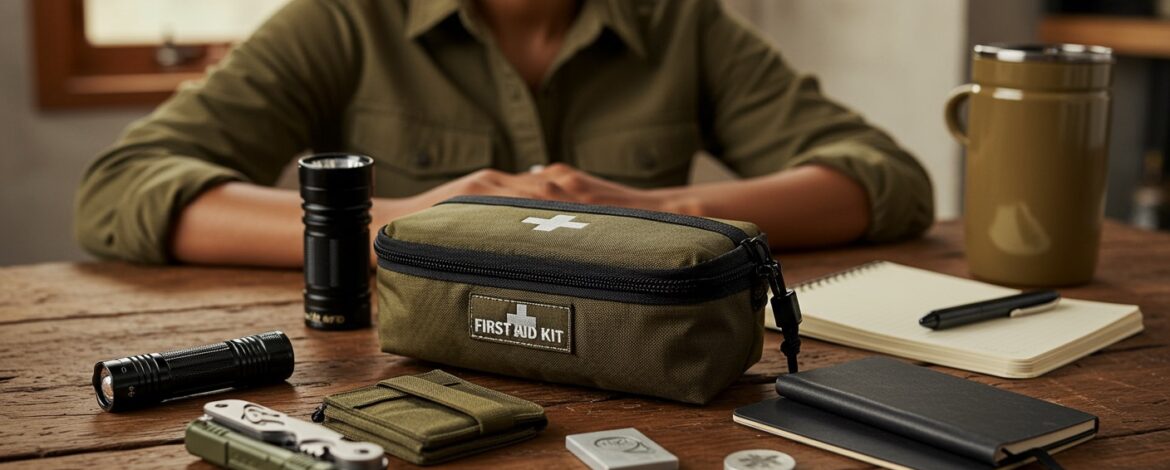Most people’s first aid preparation falls into two extremes: either a dusty box of plasters from 2015, or an expensive pre-made kit filled with items they don’t know how to use. Building an effective everyday carry (EDC) first aid kit requires understanding the difference between minor injuries you’ll treat regularly and serious emergencies that might never happen – but could save a life if they do.
Understanding the Two-Tier Approach
Your EDC first aid needs break down into two categories: boo-boo kits for everyday minor injuries, and trauma supplies for serious, life-threatening emergencies. Most people need a robust boo-boo kit and basic trauma supplies. The ratio depends on your lifestyle, training, and risk exposure.
Boo-boo kits handle cuts, scrapes, burns, blisters, headaches, and minor injuries. You’ll use these items regularly – they’re your practical, everyday medical supplies. Trauma kits address severe bleeding, chest injuries, and medical emergencies where minutes matter. You might never use them, but having them when needed makes the difference between life and death.
Essential Boo-Boo Kit Items
Start with items you’ll actually use. Adhesive plasters in various sizes handle most minor cuts. Include fabric ones that flex with movement, not cheap plastic versions that fall off. A dozen assorted plasters covers most situations.
Sterile gauze pads (75mm x 75mm) clean wounds and apply pressure to bleeding. Pack at least five. Add medical tape to secure gauze – fabric tape works better than plastic and won’t irritate skin as much. Include alcohol prep pads or antiseptic wipes for cleaning wounds. In South Africa’s climate, keeping wounds clean prevents infection in our warm, dusty conditions.
Antibiotic ointment reduces infection risk for minor cuts and scrapes. A small tube of Betadine or generic antibiotic cream is sufficient. Pain relievers like paracetamol or ibuprofen handle headaches, minor pain, and reduce inflammation. Blister plasters are invaluable if you do any walking – our hot climate and outdoor lifestyle make blisters common.
Tweezers remove splinters and debris from wounds. Small scissors cut tape, gauze, and clothing if needed. Disposable gloves (at least two pairs) protect you when treating others and should be in every kit, regardless of size.
Trauma Supplies That Matter
Serious injuries require different tools. The most critical skill in emergency medicine is stopping severe bleeding. This is where trauma supplies earn their place.
Pressure bandages (Israeli bandages or equivalent) apply focused pressure to bleeding wounds. They’re designed for one-handed application – crucial if you’re treating yourself. One or two pressure bandages handle most severe bleeding scenarios. These are more effective than improvising with regular gauze.
Tourniquet is controversial among those without training, but modern tourniquets like the CAT or SWAT-T are designed for self-application. If someone is bleeding from a limb wound severely enough to threaten their life, a tourniquet buys time until professional help arrives. In South Africa, where response times can be lengthy depending on location, tourniquets save lives. However, get proper training – incorrectly applied tourniquets cause harm.
Chest seals treat penetrating chest injuries (stab or gunshot wounds). They’re specialized items requiring training to use correctly. If you carry a firearm or work in high-risk environments, consider including them and getting proper trauma training.
Haemostatic gauze (like Celox or QuikClot) helps blood clot faster in severe wounds. It’s expensive but effective for serious bleeding that pressure alone won’t control. This is advanced trauma care – know how to use it before carrying it.
The South African Context
Our unique environment influences kit contents. Burn gel or dressings are valuable – braais, camping, and our outdoor culture mean burn injuries are common. Antihistamines help with allergic reactions to insect bites or stings. Consider oral rehydration salts if you spend time outdoors in our heat.
If you live in rural areas or travel frequently between cities, your kit needs more depth. Response times in remote areas mean you’re managing injuries longer before professional help arrives. Urban dwellers might prioritize trauma supplies given higher crime rates in certain areas.
Snake bite kits are largely useless – modern medical advice says immobilize the limb, keep the victim calm, and get to hospital immediately. Pressure bandages can help with immobilization, but specialized snake bite kits often contain outdated or dangerous items.
Training Matters More Than Gear
The best first aid kit is useless without knowledge. A pressure bandage won’t help if you don’t know when or how to apply it. Consider taking a first aid course – many organizations offer training from basic first aid to advanced trauma care. The Red Cross, St John Ambulance, and private training companies throughout South Africa provide courses.
Start with basic first aid, then add trauma training if your lifestyle or work warrants it. Stop the Bleed courses specifically teach hemorrhage control and are increasingly available in major cities.
Building Your Kit
Begin with a quality container – waterproof, durable, and appropriately sized. A small belt pouch works for vehicle EDC, while a larger kit makes sense for home or office.
Minimum viable EDC kit: Assorted plasters, gauze pads, medical tape, antiseptic wipes, antibiotic ointment, pain relievers, gloves, tweezers, scissors, and one pressure bandage.
Enhanced kit: Add tourniquet, more pressure bandages, burn dressings, additional gauze, triangular bandage for slings, antihistamines, and any personal medications you or family members need.
Check your kit every six months. Replace expired items, restock used supplies, and refresh your knowledge. The best first aid kit is one that’s current, accessible, and backed by training. Start simple, learn as you go, and expand based on your actual needs and capabilities.

